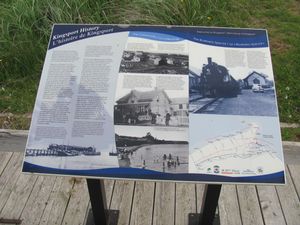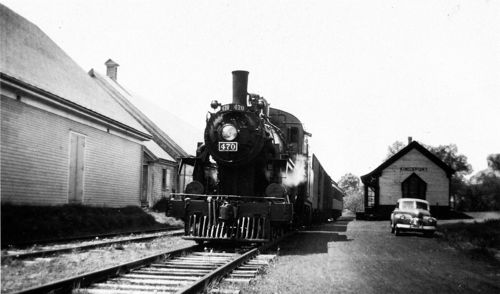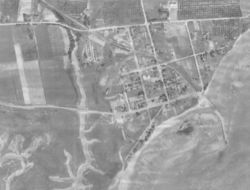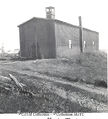Dominion Atlantic Railway Digital Preservation Initiative - Wiki
Use of this site is subject to our Terms & Conditions.
Kingsport
Kingsport, Nova Scotia
- Subdivision Kingsport, Mile 13.6
Previous Station: Pereau
Kingsport was the eastern terminus of the Cornwallis Valley Railway branchline of the Dominion Atlantic. The village served as an important shipping point and interchange between rail and ocean transport from 1890 until 1961.
Facilities
Kingsport Station, north side of main line Siding for two apple warehouses opposite station, south side of main line:
- Section House at east switch of wye
Wye and Kingsport Enginehouse
Spur line to Kingsport Wharf
- Double track siding at wharf, 2nd track taken up by 1911
Waiting room/freight shed and lighthouse at end of wharf
History
Previously inhabited by Mi'kmaw and Acadians, Kingsport was settled by New England Planters in the 1760s. A first known as Indian Point and Oak Point, it became Kingsport in the 19th century as ship yards and a shipping pier made it the leading port in Kings County. Major wooden shipyards built a series of large square-rigged sailing ships from the 1850s to the 1890s. As wooden shipbuilding declined in the face of iron steamships, investors in the area pooled money to bring the railway to Kingsport, the Cornwallis Valley Railway (CVR) which connected to the Dominion Atlantic at Kentville. Railway construction began in 1889 and the line went into full service in 1890, triggering a major increase in the apple industry. Apple warehouses were built at almost every crossing along the CVR, one every three miles including two inside the wye facing the station at Kingsport.[2]
The Kingsport Wharf, originally built to serve the shipyard and extended for coast shipping was extended to service ocean steamships with a railway spur along its entire length. Apples, potatoes and lumber were exported while coal, fertilizer, general freight and even Sable Island horses were imported. Kingsport was also part of the Minas Basin ferry route for passengers, freight and vehicles carried out by a series of steamships, the SS Evangeline, SS Prince Albert and later the MV Kipawo which connected Kingsport to Parrsboro and Wolfville from 1890 until 1940.
A number of industries operated in Kingsport following the railway's arrival including a saw mill, moulding mill, two boat builders and in the first few years of the railway, a ship repair operation in the old shipyard. Kingsport's population peaked in this era at over 700 people. While the mills eventually declined, rail-related tourism grew as several hotels such as the Sunnyside Inn and the Longspell Inn were built for summer tourists and a colony of summer cottages grew around the village and beach.
The railway operations at Kingsport centred on a large wye with a single stall enginehouse where the branch line locomotive received light servicing and stayed overnight. Because of the short distance to Kentville, there were no water or coaling facilities. Kingsport was home to many of the regular train crews on the branchline and also a summer home to some DAR employees who owned cottages there.
Kingsport generated brisk passengers service in its first years, reaching the height in 1914 of six trains a day (eight on Saturdays!) several with express service for shoppers and commuters.[3] A lasting service were morning and afternoon "school trains" which took generations of older children from Kingsport to the high school in Kentville.[4] The growth of automobile traffic eroded passenger service but Kingsport maintained four mixed-trains a day until rail service was abandoned in 1961, although the priority shifted to freight. The slow speed and extensive shunting of the Kingsport mixed trains in their two final decades earned them the commonplace nickname of "blueberry specials." Canadian Pacific tried a bus service from Kingsport to Kentville from April 1947 until May 1949.[5], in addition to its mixed train passenger service, but reverted to trains only for the duration of rail service.[6] Apple traffic remained the mainstay of the line but the loss of the British export market after World War II and the public expansion of highways diminished the remaining freight on the line leading to abandonment in 1961. Kingsport's population declined in the 1940s and plunged after World War II, falling to 224 people by 1956.[7]

The Kingsport community rallied in the 1990s becoming a bedroom community for the Wolfville-Kentville area. Investments were made in a revitalized park around the old railway wharf; a community centre and CAPS site built in an old general store; and an annual community fair and parade called "Kingsport Gala Days".
Framed by the tracks of the wye and the spur to the railway wharf, the daily arrivals, departures and shunting of the railway defined memories of life in Kingsport for generations. Images of trains meeting ships on the wharf became an icons for the history of the community. Physically, only a few visible traces remain of the railway in Kingsport today as the station and warehouses were destroyed in fires after abandonment and the roadbed was sold to adjacent landowners and mostly graded over. Portions of the engine house foundation now serve as a automobile garage foundation. A section of the overgrown, sunken roadbed that led to the wharf remains as does a stub of the railway wharf, now a parking lot, boat ramp and look-off with interpretive signs that discuss the railway era. The compact geography of railway features in Kingsport has led two railway modelers to create Kingsport in HO scale: Paul Bushnell and Dan Conlin.
Operations & Orders
1931 - Engines are not to switch within 150 feet of the end of outer end of the track on the wharf.[8]
1936 - Switching restriction on wharf not longer applies. Train No. 14 will not leave Kingsport until Train No. 11 has arrived. Train No. 18 will not leave Kingsport until Train No. 13 has arrived.[9]
Gallery
Kingsport Wharf at the launch of the barquentine Skoda with three DAR flatcars on the wharf siding, June 1, 1893.
Kingsport Wharf, high and low tide views, with flatcars and gondola on wharf siding, circa 1900.
Map of the Cornwallis Valley Railway/Kingsport Subdivision, detail from "Kingsport" Sheet No. 84", Geological Survey of Canada Map, 1911.
Kingsport Wharf with Locomotive No. 12; Combine No. 24 (behind engine) and Combine No. 31 meeting the DAR ferry SS Prince Albert, summer 1911.
Combine No. 24 (behind engine) and No. 31 with Locomotive No. 12 in a detail of a Kingsport Wharf photo, c. 1911
Locomotive No. 13 "Gabriel" at the Kingsport Station, circa 1895-1911.
Kingsport in winter with cars at the Kingsport Fruit Company warehouse and the Mayflower Fruit Company warehouse along with combine No. 31 at end of train and Kingsport Station on right circa 1920.
Ephraim Hiltz inside the Kingsport Enginehouse with locomotive No. 21, circa 1915.
DAR Inspection Car on the Kingsport Wharf, circa 1914-18.
DAR locomotive No. 21 with southbound train at the Kingsport Station with crew and locals, circa 1920.
Kingsport Wharf, from the east, with a DAR locomotive and the combine car No. 32 "Daphne", circa 1920.
Postcard of level crossing in Kingsport, looking south along Main Street, 1920s
Locomotive No. 33 and caboose 435786 at Kingsport Beach, at the head of the Kingsport Wharf, circa 1920s.
Air photo showing Kingsport on the DAR's CVR branchline, Sept. 30, 1931.
The Kingsport Wharf with refrigerator car and visiting float plane beside the DAR freight shed and schooner F.B.G., circa July 1936.
Kingsport Wharf with MV Kipawo meeting a 4-4-0 locomotive pulling a passenger coach, Combine No. 31 and two boxcars, August 1936.
Kingsport Wharf and freight shed, Summer 1940.
Plan of the Kingsport Wharf after reconstruction, June 12, 1942.
Locomotive No. 470 with crew at Kingsport Station, June 1943.
Locomotive No. 470 with crew at Kingsport, August 1943.
Air photo of Kingsport, the Kingsport Wharf, apple warehouses and train parked at the Kingsport Station, July 27, 1945.
Kingsport Station agent and crew of the Kingsport train at the Kingsport Station, summer 1946.
DAR locomotive No. 470 with Train No. 11 at the Kingsport Station, circa 1942.
Locomotive 470 at the Kingsport Station with the Mayflower Fruit Company warehouse and the Kingsport Section House, 1946.
Starr Williams, driver, at Kentville Station with the short-lived Kingsport bus, circa April, 1947.
Kingsport Station, 1959.
The Kingsport Wharf, the final terminus of the CVR, showing the second DAR freight shed on the wharf in the last days of the subdivision, circa 1960.
Kingsport Enginehouse from the north east showing surrounding landscape, 1958.
Kingsport Enginehouse north end facing the engine doors from the wye track, 1958.
Interpretive sign at Kingsport Wharf, 2015.
References and Footnotes
- ↑ Map 13 A "PROVINCE OF NOVA SCOTIA, Kings and Hants Counties, Kingsport Sheet No. 84"; Hugh Fletcher, L. N. Richard, Geological Survey of Canada, Dept. of Mines, Canada, Multicoloured Geological Map 1037, 1911
- ↑ "Place Names of Nova Scotia", Nova Scotia Archives and Records Management, p. 332
- ↑ "When eight trains and two steamships served tiny Kingsport, NS" Parker Donham, The Contrarian July 6, 2016
- ↑ Parker Donham, "Kentville townies v. Medford farm girls" The Contrarian July 10, 2016
- ↑ William E. Miller, "Canadian Pacific Transport Company", Electric Lines in Southern Ontario, October 20, 2009, trainweb.org
- ↑ Ed Coleman, "Gone and Almost Forgotten the CVR Bus", Kings County Advertiser Register, 17 April 2013
- ↑ "Place Names of Nova Scotia", Nova Scotia Archives and Records Management, p. 333
- ↑ "Time Table No. 77 For Employees June 21, 1931", Dominion Atlantic Railway, p. 3
- ↑ "Time Table No. 90 For Employees June 28, 1936", Dominion Atlantic Railway, p. 3
- Dominion Atlantic Railway Employee Time Table September 25, 1949, Library and Archives Canada, pmp -HE.2804 DC



































